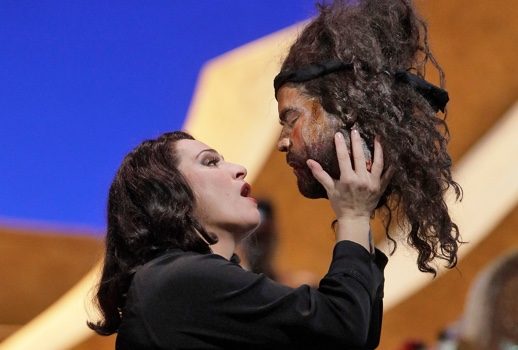

“And I want to see her survive the grisly experience and turn it into glory.” It’s a dynamic I find compelling too. The diva transformed, newly forged and phoenix-like, seeking revenge through artistic ferocity. Where there was once an aversion, a demure glance away, there is now a grotesque and thrilling fascination, burning into our eyes.
A similar cycle of humiliation and glory is one of the many reasons I love Strauss’ Salome; and it’s the same reason that, perhaps, divas throughout the last century have been drawn to Tetrarch’s terrace. In fact, I can think of no other role that provides the most unique promise of humiliation, and consequently the most opportunity for glory.
The role’s demands are staggering. In merely one act, the soprano must wrestle with a large orchestra while traversing a wide vocal range, project a girlish immaturity, dance (ostensibly) the dance of the seven veils, perhaps get naked, and perform necrophilia with a severed head. While critics and aficionados compare Salome to other roles within the expressionist canon (Elektra, Lulu), I am hard pressed to imagine a more vocally or emotionally demanding task for its central figure—no other piece in which a singers’ body and art are so exposed.
This exercise gestures toward vulgarity—a notion that directors have exploited throughout Salome’s performance history. Jürgen Flimm’s conservative production at the Met, this season starring the indomitable Patricia Racette, works against this through displays of elegance and wealth, conjuring 20th century chic, with all its attending atrocities. There is little blood dripping from the prophet’s neck. Instead, dark angels of death gather on the dunes surrounding the palace, like a flock a vultures waiting for Salome’s demise. In the meantime, the costumes shimmer and shine, recalling the glamorous surfaces of Wilde’s original text—the jewels and capital Herod promises to Salome in a last ditch effort to avoid her sickening demand.
For those unfamiliar with the source material, Strauss’ Salome is based on the notorious play by Oscar Wilde—which is in its own way an obscene fantasia on short biblical passages from the gospels. In the opera, Salome dances for Herod in order to receive the head of John the Baptist on a silver platter. Her desire for his head is born out of an acute need to possess the prophet sexually.
For Wilde, the play is an opportunity to indulge a preoccupation with surfaces, beauty, and idolatry. Long passages are given to vivid descriptions of material objects—the moon, rubies, ivory, and flowers—all in an intoxicating prose that engages and hypnotizes the senses. Strauss’ intervention in this aesthetic is to bring a high-pitched, modernist lens to the discourse, with a temperamental score that seethes and writhes with explosive beauty.
In the Met’s current performances, Racette elegantly transforms Salome’s humiliation into one of glory. Her voice, more lyrical than that of a traditional Salome, allows her work to highlight the hubris that propels the character toward own her heart of darkness. Her dance of the seven veils especially impresses, in which the singer handles the demanding movement and resulting nudity with courage and skill.
However, it is in the final scene, where music and text turn most ambivalent, that Racette’s artistry begins to flourish. Her tireless voice and lyrical approach enact the deep well of longing that Salome mismanages.
As Jochanaan, the single-minded prophet, Zeljko Lucic is serviceable, though disappointing. Frankly, I find his singing is more effective when amplified from the cistern prison than we he actually appears onstage. And though the character of Jochanaan coopts the position of moral arbiter throughout the evening, paving the way for the radical ethics of Christ, I find Lucic interpretation to lack empathy, bordering on a mean-spirited, stingy misogyny.
Lucic does better with a wonderfully unhinged Herod. He topples back and forth in the grips of lust and aversion, manipulated by his whims and women. Usually, Herod’s reaction to Salome’s dance seems forced and one-dimensional. But Siegel pulls off his incestuous attraction to Salome, and his voice bites through the gnarly textures of the orchestra with sharp vigor.
Nancy Fabiola Herrera is equally demented as Herodias, less master-manipulator and more detached aristocrat. She flounces about the stage, spitting out thick, juicy notes with ease. Also, two debuts at the house are happily worth mentioning, despite their brevity within the opera. As Narraboth, Kang Wang trumpets a clarion tenor, successfully negotiating the bizarre passions of the self-destructive soldier. And Nicholas Brownlee, as First Soldier, displays an exiting, rich bass-baritone. One hopes for more from these two at the house in the future.
Conductor Johannes Debus debuts with a somewhat lethargic Met orchestra. And yet, their playing still demonstrates all the angst, aggression, and transcendence of Strauss’ score, which lurches toward its inevitable conclusion with a force that enchants and sickens.
Ultimately, the opera transforms the humiliation of Salome into something unbearable—much like Koestenbaum’s vision of Minnelli—one whose brilliance fascinates me, just as it forces me to look away. This Salome burns bright. Perhaps too bright. Like Herod, one asks for the moon to darken, the torches to be put out. The glory of Salome is too much; we avert our eyes, an the curtain swoops down to block her from view.
Photo by Ken Howard/Metropolitan Opera

























Comments